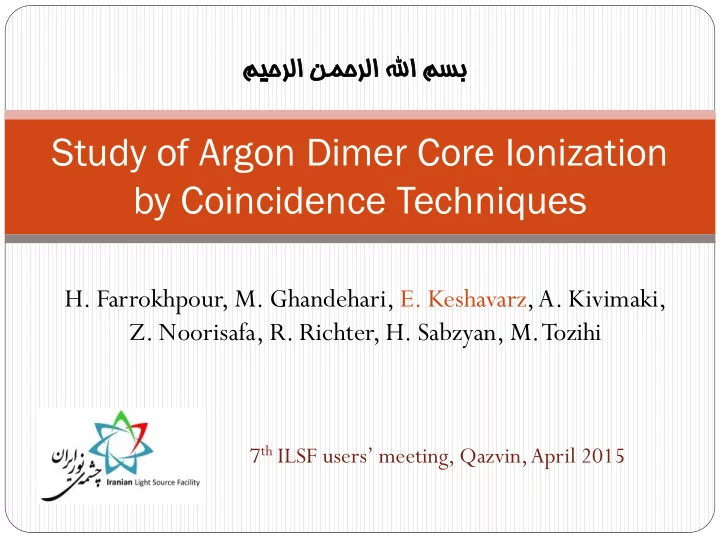

ميحرلا نمحرلا للوللوا مسب Study of Argon Dimer Core Ionization by Coincidence Techniques H. Farrokhpour, M. Ghandehari, E. Keshavarz, A. Kivimaki, Z. Noorisafa, R. Richter, H. Sabzyan, M. Tozihi 7 th ILSF users ’ meeting, Qazvin, April 2015
Introduction Van derWaals interactions in inert gas clusters • Core electron excitation/ionization and relaxation channels (Auger, RCT, ICD, ETMD) • Fragmentation process monitoring by coincidence techniques h ν (PEPECO, TPEsCO, PEPICO, PIPICO, PEPIPICO, FPICO, RCT FPIPICO) Auger ICD Auger 2 1 . Cederbaum, et al. PRL , 1997 , 79 , 4778. 2. Kreidi, et al. PRA , 2008 , 78 , 043422.
Experimental method Elettra GasPhase beamline (13.5-900 eV) 3
Experimental setup-1 PhotoElectron-PhotoIon-PhotoIon Coincidence spectroscopy (PEPIPICO) h ν h ν = 255 − 340eV, Δ E/E ~ 30meV t ~ − 56 ° C 4
Results-1 Time-of-flight spectrum 5
Results-1 Mass spectrum Conditions optimization Ar Ar Ar 2 Ar 2 Ar 3 Ar 4 6
Results-1 Coincidence spectrum Ar 2 Ar Ar 2 3 2 Ar Ar Ar 2 4 3 Ar Ar Ar 2 4 2 2 Ar Ar Ar 2 7
Results-1 Photon energies Ionization product Photon energy (eV) 255 eV 2p − 1 248.628, 250.776 3/2,1/2 274 eV 2p − 1 3p − 1 4p ~ 270 − 275 325 eV 2s − 1 4p 323.6 330 & 340 eV 2s − 1 326.26 1 . King, et al. J. Phys. B 1977 10 , 2479. 2. Avaldi, et al. J. Phys. B 1994 27 ,3953. 8 3. Sankari, et al. Phys. Rev. A 2002 65 ,042702. 4. Glans, et al. Phys. Rev. A 1993 47 ,1539.
Results-1 Channels intensity Ar + + Ar + Ar 2+ + Ar + Ar 3+ + Ar + Ar 2+ + Ar 2+ 9
Results-1 Relaxation channels (255 eV) Auger decay RCT Ar + (2p -1 )Ar Ar 2+ (3p -2 )Ar Ar + (3p -1 )Ar + (3p -1 ) Auger decay ICD Ar 2+ (3s -1 3p -1 +3p -3 3d)Ar Ar 2+ (3p -2 )Ar + (3p -1 ) double Auger decay RCT Ar 2+ (3p -2 )Ar + (3p -1 ) Ar 3+ (3p -3 )Ar double Auger decay ETMD Ar 2+ (3p -2 )Ar 2+ (3p -2 ) Ar 3+ (3s -1 3p -2 )Ar double Auger decay ICD Ar 3+ (3s -2 3p -1 )Ar Ar 3+ (3p -3 )Ar + (3p -1 ) h ν RCT ICD 1. Saito, et al. Chem. Phys. Lett. 2007 , 441 , 16. 2. Bruken, et al. PRA 2002 , 65, 042708. 10 3. Stoychev, et al. J. Chem. Phys . 2008 , 128 , 14307. 4. Nakano, et al. PRA 2012 , 85, 043405.
Results-1 Relaxation channels (330 & 340 eV) Auger decay Ar 3+ (3p -3 )Ar RCT Ar 2+ (3p -2 )Ar + (3p -1 ) Ar + (2s -1 )Ar Coster-Kronig Ar 2+ (2p -1 (3s,3p) -1 )Ar Auger decay ETMD Ar 2+ (3p -2 )Ar 2+ (3p -2 ) Ar 3+ (3s -1 3p -2 )Ar Auger decay ICD Ar 3+ (3s -2 3p -1 )Ar Ar 3+ (3p -3 )Ar + (3p -1 ) double Auger decay RCT Ar 3+ (3p -3 )Ar + (3p -1 ) Ar 4+ (3p -4 )Ar Ar 3+ (3p -3 )Ar 2+ (3p -2 ) ETMD double Auger decay Auger decay Ar 3+ (2p -1 3p -2 )Ar ICD Ar 4+ (3s -1 3p -3 )Ar Ar 4+ (3p -4 )Ar + (3p -1 ) 1. Kylli, et al. PRA 1999 , 59 , 4071. 2. Lablanquie, et al. PRL 2000 , 84, 47. 11 3. Bruken, et al. PRA 2002 , 65, 042708 . 4. Sakai, et al. PRL 2011 , 106, 033401.
Results-1 Kinetic energy release estimation 2 v m t 2 0 t max qE max intensity half max intensity T 2 t 12
Results-1 Kinetic energy release estimation Spectrum est. of Coulomb est. of KER KER Ar + + Ar + 4.5 eV 3.8 eV Ar 2+ + Ar + 6.0 eV 7.6 eV Ar 3+ + Ar + 7.8 eV 11.0 eV 13
Phys. Rev. A 89 , 053409 (2014) 14
15
Experimental setup-2 Flourescence-PhotoIon-PhotoIon Coincidence spectroscopy (FPIPICO) monitoring RCT process h ν -200 V -300 V +2.4 kV 16
Results-2 Coincidence spectrum (~249 eV) 17
Experimental setup-3 fast ion- fast ion coincidence spectroscopy -1.5 V +15 V -2.3 kV 18
Results-3 Coincidence (TOF) spectrum 19
Results-3 Energy scan spectra 3/2 3/2 3/2 2 p 3d 2 p 4d 2 p 5d 2 1/2 2 1/2 2 1/2 p 3d p 4 d p 5 d 3/2 2 p 4 s 2 1/2 monomer spect. p 4 s dimer spect. 20 Avaldi, et al. J. Phys. B 1994 27 ,3953 .
21
Acknowledgment Prof. Robert Richter Dr. Hossein Farrokhpour Prof. Hassan Sabzyan Prof. Antti Kivimaki Dr. Zeinab Nourisafa Dr. ManijehTozihi Maryam Ghandehari Abdus Salam International Center for Theoretical Physics (ICTP) University of Isfahan 22
23
24
25
26
27
Relaxation channels (274 eV) RCT Ar + (2p -1 3p -1 np)Ar Auger decay Ar 2+ (3p -2 )Ar Ar + (3p -1 )Ar + (3p -1 ) Auger decay ICD Ar 2+ (3s -1 3p -1 +3p -3 3d)Ar Ar 2+ (3p -2 )Ar + (3p -1 ) Auger decay autoionization Ar 2+ (3p -3 np)Ar RCT Ar 3+ (3p -3 )Ar Auger decay Ar 2+ (3s -1 3p -2 np)Ar Auger decay double Auger decay RCT Ar 3+ (3p -3 )Ar Ar 2+ (3p -2 )Ar + (3p -1 ) double Auger decay ETMD Ar 2+ (3p -2 )Ar 2+ (3p -2 ) Ar 3+ (3s -1 3p -2 )Ar double Auger decay ICD Ar 3+ (3s -2 3p -1 )Ar Ar 3+ (3p -3 )Ar + (3p -1 ) 28
Relaxation channels (325 eV) 29
Ne 2s ionization photons electrons 30
Recommend
More recommend